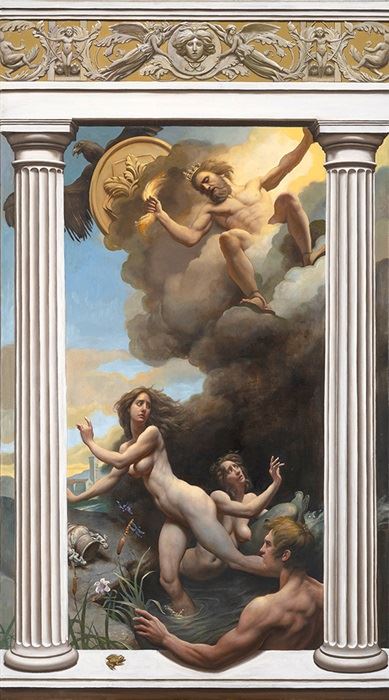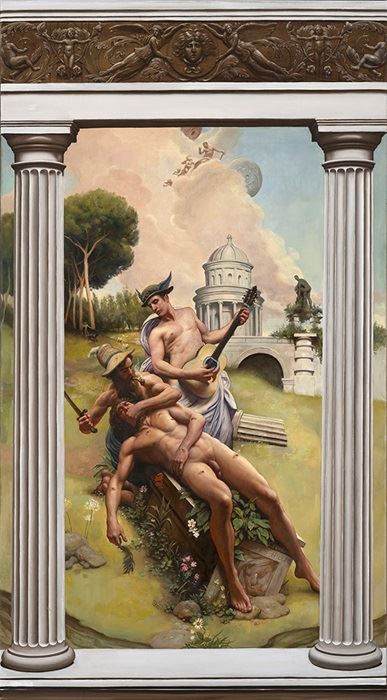Adam Miller’s Metamorphoses – MutualArt.com
Adam Miller is best-known for his mannered method of painting intricate compositions of multiple figures with the exciting twists and tropes of the late renaissance combined with the costumes and customs of our current era.
Adam Miller, Suspicious Hera Takes Io Prisoner, 2023, Oil on canvas, 150 x 83 cm, 59 x 32,5 in
For his recent inspiration Miller has revisited Ovid’s Metamorphoses, a series of delightfully imaginative and ancient tales of the gods and their human playthings written for the readers of Augustus Caesar’s Roman Empire formed at the first breath of the current era. Miller understands the seductive nature of allegory as a useful tool for passing on the ideas of our classical ancestors. “The more recent pieces present the story as straight and accurately as I can, and let the archetypal, deep resonance of that story do its own magic,” Miller explains, “to see which magic is stronger, the magic of adapting, or presenting something straight. I think presenting something straight is more powerful, but it’s less easy to get people to embrace the ideas.” Four of Miller’s new paintings retell the myth of Zeus and the priestess Io, showing the god’s descent from the heavens when he first sees Io bathing in a river. Zeus’ wife Hera is horrified by her philandering husband’s seduction of Io and turns her into a cow, contemptuously rides on her back, and sets Argus as her guard, but Zeus wants his mistress returned to human form, and sends Hermes to kill Argus and free her. Hermes restores Io, and Zeus and Hera are reconciled. In another painting Europa rides Zeus, who has taken the form of the most beautiful white and muscular bull to seduce her into adorning his perfectly sculpted horns with garlands, and caressing his perfect body. Miller has painted the moment when Zeus swims into the ocean with Europa on his back.
Adam Miller, Zeus Spots Io and Falls in Love, 2023, Oil on canvas, 150 x 83 cm, 59 x 32,5 in
Romans loved Ovid’s rambunctious and vulgar ride through the classical literature of the Greeks, his sensual stories of change and the chaotic consequences of hubris and lust, and Metamorphoses has been a pleasure for artists and readers for two millennia. The stories are often violent and lasciviously erotic, showing the fickle gods as dangerous entities, and Ovid uses the allegories of these fantastic beings to comment on political and military actions – for example, the story of Cadmus, the founder of Thebes, who profaned the holy grove of the dryad to take water from the sacred spring, and slaughtered her dragon guardian by spearing it to a hallowed oak, is clearly an allegorical description of the invasive and genocidal expansion of the empire into Celtic lands and the destruction of the druids’ wooded nemeta enclosures. The story of Cadmus sowing the dragon’s teeth which grew into armed men who fight bitterly is as much an entertaining origin myth as it is an allegory of the internal dissent and power struggles which grew in proportion to the growing scale of the empire.
Adam Miller, Hermes Lulls Argus to Sleep with Music, 2023, Oil on canvas, 150 x 83 cm, 59 x 32,5 in
Miller’s pre-pandemic paintings of the story of Diana and Actaeon stage his skill and epitomize his approach as a subtle commentator on the new great game of geo-politics. In Ovid’s story, the goddess was bathing naked in her grove with her attendant nymphs, who were the guardian spirits of the forest, when the hunter Actaeon penetrated the sacred space and saw her nudity. Actaeon was the grandson of the city-builder Cadmus. Thus, Actaeon’s invasion was a multi-generational desecration of the primordial nemeton. Outraged at the invasion of her privacy, Diana was filled with ferocious anger stirred by the renewed violation of her sacred space, and the blasphemous sins of Actaeon’s familial past. Naked, and unable to reach for her arrows to kill the intruder with convention, but guided by passion to vengeance, she threw holy water from her spring over him and transformed him into one of the deer he sought to kill. Ovid wrote, “…she gave the horns of a mature stag to the head she had sprinkled, lengthening his neck, making his ear-tips pointed, changing feet for hands, long legs for arms, and covering his body with a dappled hide. And then she added fear.” Actaeon ran, seeking refuge, but his friends had no idea that he was now a stag, and urged his dogs into the hunt, and he was soon run down and attacked as prey. Ovid vividly described the bloody scene of his death, even naming the leading dogs: first “Black-hair” Melanchaetes wounded Acteon’s back, while “Killer” Theridamas, and the “Climber” Oresitrophos clung to his shoulder and brought him down, then
Source: News


